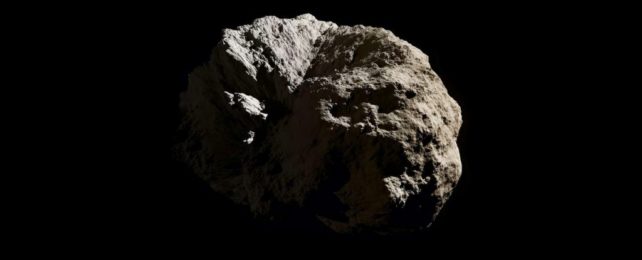There are a heck of a lot of asteroids in the Solar System that orbit the Sun.
We know of around 1 million. And almost all of those asteroids are beyond the orbit of Earth, in the farther reaches of the mid- and outer-Solar System. Just a few have been discovered entirely inside Earth's orbit.
Models suggest that there ought to be a population of asteroids even closer to the Sun, entirely constrained within the orbit of Venus. To date, we have found just one: the asteroid 'Ayló'chaxnim, discovered in 2020. Its name means 'Venus girl' in the Luiseño language.
Yet 'Ayló'chaxnim defies our expectations: It's a size that models say is too large to be an inner-Venus asteroid.
Scientists have been taking a closer look at the rock to see if they can figure out what it is, how it got there, what its future holds, and if it can lead us to more inner-Venus asteroids.
A paper describing the findings, led by astronomer Bryce Bolin of Caltech, was accepted by Monthly Notices of the Royal Astronomical Society and is available on preprint server arXiv.
According to models based on the known population of near-Earth asteroids, the inner-Venus asteroid population should consist of rocks around 1 kilometer (0.62 miles) in diameter or below.
However, finding these asteroids is hard; they tend to be quite close to the Sun in the sky, which means we can only find them in the short time between sunset (or sunrise) and full dark. Because they're small, and far away, this is no mean feat.
Initial observations of 'Ayló'chaxnim, first detected using the Zwicky Transient Facility, and followed up using a number of different instruments, suggested that the asteroid is around 2 kilometers in diameter. It has a reddish hue, consistent with S-type asteroids from the inner Main Belt of asteroids that orbits the Sun between Mars and Jupiter.
At the furthest reaches of its orbit, the asteroid flies out roughly just 0.65 astronomical units of the Sun. Venus' orbital distance is 0.72 astronomical units.
By collecting all the observations, analyzing the data, and running simulations, Bolin and his colleagues determined that 'Ayló'chaxnim is around 1.7 kilometers in diameter and migrated to its current position from the Main Belt.
This is consistent with previous findings and modeling that suggests any asteroids with 'Ayló'chaxnim's orbital profile should come from the Main Belt.
However, Bolin and his team also found that 'Ayló'chaxnim only arrived at its current position relatively recently, cosmically speaking, within the last million years or so. And it's not likely to remain there long. In the team's simulations, 90 percent of the 'Ayló'chaxnim clones had a gravitational interaction with a planet that resulted in a collision with either a planet or the Sun within 30 million years.
For the clones that survived, within 50 million years, 13 percent collided with the Sun, while another 13 percent, 52 percent, 16 percent, and 2 percent collided with Mercury, Venus, Earth, and Mars, respectively.
The remaining 4 percent of that 10 percent survives longer than 50 million years, or it ends up ejected from the Solar System entirely. That gives 'Ayló'chaxnim just a 0.04 percent survival rate beyond 50 million years.
This relatively short time of stability could be why we haven't found many inner-Venus asteroids. It's also worth noting that the first objects found in any cosmic population tend to be the outliers, giving us a big enough signal to detect.
'Ayló'chaxnim is bigger than models accounted for, but it might just be a big oddball, and the smaller swarm is outside our current detection capabilities – or we just need to look a bit harder.
And that's what Bolin and his team recommend we do. The team's simulations suggest that 'Ayló'chaxnim could have an 0.16 percent chance of colliding with Earth within 50 million years. Those are small odds, but still non-zero. If there are more asteroids out there with those odds, we want to know about them.
"The twilight sky within 50 degrees of the Sun is relatively unexplored and the comparison between observations and asteroid population models requires future exploration of this phase space," they write in their paper.
"Observations of the near-Sun sky by current surveys … along with future surveys … will provide coverage of the near-Sun sky and the inner-Venus asteroid population."
As 'Ayló'chaxnim was the first of these asteroids to be officially detected, identified, and named, the team proposes that this population be called 'Ayló'chaxnim asteroids.
The research has been accepted into the Monthly Notices of the Royal Astronomical Society and is available on arXiv.
